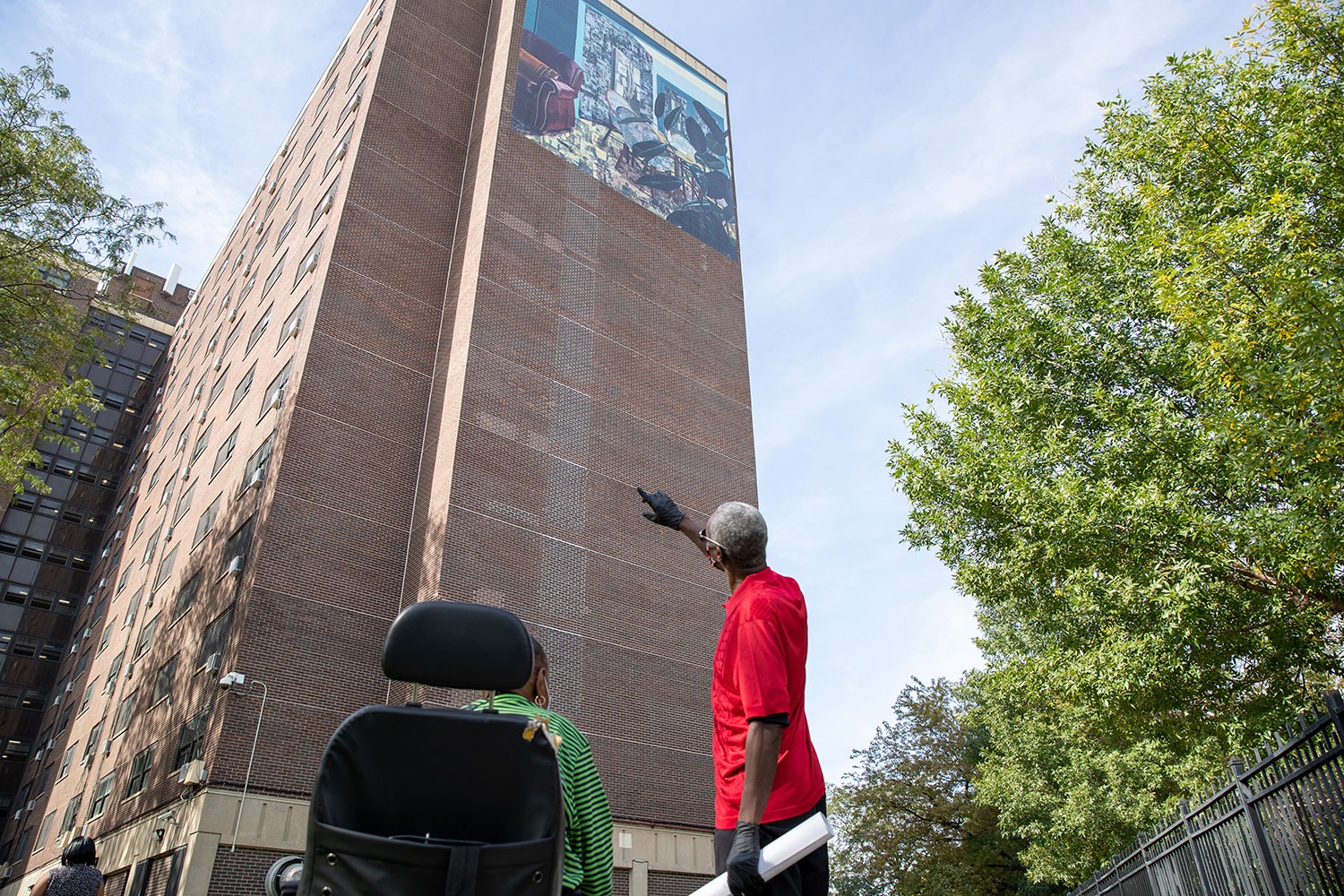The Minnie Julia Riperton Apartments — yes, named after that Minnie Riperton, the “Lovin’ You” singer who trilled notes higher than a wood thrush playing a pennywhistle, the mother of Saturday Night Live’s Maya Rudolph — are drab even by the utilitarian standards of the Chicago Housing Authority. Opened in 1969, and representative of that decade’s bland, brutal public architecture, the building is a 14-story hinged box of brown brick and gray concrete stained by half a century of Midwestern winters. But look up — upupupup — crane your neck, squint against the sun, and see, hanging from two blank facades, a pair of murals depicting African-American family life. They were painted by Njideka Akunyili Crosby, a MacArthur Genius Grant-winning artist originally from Nigeria, and chosen by the residents, making the Minnie Riperton Apartments the only CHA building that doubles as an outdoor art gallery. It’s become a point of pride for the people living there.
“They wanted to put out something that the general public notices these buildings were here,” said Jerrold Herman, 66, who has resided at the senior building for a decade. “You could see it, but there wasn’t any reason to notice it. Then there’s you coming home to a plain place versus you coming home to a place with a mural. That’s where you stay. It’s an extra incentive to look up. If you look up, your head is high and your shoulders are back and all’s right with the world.”
The general public may not have noticed the Minnie Riperton Apartments because the building is at 42nd Street and Princeton Avenue, in Fuller Park, one of the city’s smallest, littlest-known neighborhoods. Fuller Park is just a few blocks wide, squeezed between the Dan Ryan Expressway and the Chicago & Western Indiana Railroad tracks. (The neighborhood is named for Chicago’s own Chief Justice Melville Fuller, whose Supreme Court issued Plessy v. Ferguson, the decision which allowed states to maintain “separate but equal” facilities for Blacks and whites. A bust of the judge stands in the courtyard of the Fuller Park fieldhouse.)
The Minnie Riperton Apartments are, however, visible from the Dan Ryan. That’s one reason they were chosen to display the murals, which were hung high enough to be seen by highway traffic. The murals are part of the Smart Museum of Art’s project “Toward Common Cause: Art, Social Change, and the MacArthur Fellows Program at 40,” which has placed art by 29 Genius Grant winners around Chicago. The Smart Museum collaborated with the CHA Teen Program to find the right artwork for the Minnie Riperton Apartments. A group of young people who live in public housing selected 16 paintings by Crosby and set up posters in the building’s hallways, so residents could choose the pair they liked best. “Home: Say It Out Loud,” is a mural of a living room overlaid with family photos. “I Still Face You,” depicts a family sitting around a table on a balcony. Loving these murals is easy, because they’re beautiful.
The murals, said 18-year-old Milan Jackson, debunk “the theory of what buildings on the South Side mean and represent to the residents there. It shows the culture that the building has. It also represents unity.”
The teenagers chose Crosby’s work for the building because it “symbolized Black family and community,” said 20-year-old Jaden Roundtree.
Jerrold Herman was “impressed” with Crosby’s catalog, but “wasn’t too crazy” about the murals selected. He liked a painting of a car, but was outvoted by the widows, who preferred domestic, family scenes.
“I like the ones that’s up there,” asserted 72-year-old Geraldine Finklea.
The Minnie Riperton Apartments were originally the Princeton Apartments. After Riperton, a Bronzeville native, died of breast cancer at age 31 in 1979, the CHA renamed the apartments in her honor. That’s another mark of distinction for the building, since most CHA properties have been named after politicians — Altgeld Gardens, Henry Horner Homes — or public housing executives — Robert Taylor Homes, Caroline Hedger Apartments. The name is as appropriate now as it will ever be, since the seniors living there grew up listening to Riperton’s music.
“She was a Black young singer, and she had a beautiful voice,” said 71-year-old Lenora Bailey.
“Like a bird,” added Finklea.
“I was more of a Chaka Khan fan myself,” judged Jerrold Herman. “I can appreciate Minnie Riperton’s talent, but it’s lite disco, lite R&B. I’m more of a heavy bass, heavy funk kind of guy.”
There’s the name of your next building, CHA.



